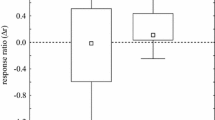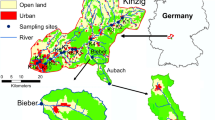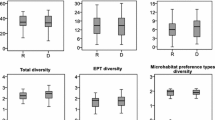Abstract
Running waters are among the most threatened ecosystems globally, having altered hydrological regimes, homogenized habitat, and impaired water quality. These multiple stressors impact aquatic biodiversity and ecosystem function across space and time, although a clear mechanistic understanding is still lacking. Here, we examined the trophic response of macroinvertebrates among streams in a Swiss lowland catchment encompassing a gradient of land uses. Clear compositional changes were observed as anthropogenic impacts increased from least-impacted to agricultural and urbanized sites. Taxonomic diversity was lowest at sites with morphological and water quality impairment (agricultural sites), whereas taxonomic identity (susceptible vs. generalist species) mainly changed due to water quality degradation (agricultural and urban sites) based on the SPEAR (pesticides) index. Using stable isotopes (δ13C, δ15N), a simplification in macroinvertebrate trophic structure was evident along the land use gradient. At a site receiving wastewater treatment effluent, stable isotopes also revealed trophic shifts in primary consumers that corresponded to changes in available food resources. Results further showed that some taxa losses, e.g., the mayfly Ecdyonurus, to land- use effects may be due to low trophic plasticity. The combination of analyses, including stable isotopes, provided an improved mechanistic understanding of community and population responses to land-use changes along river networks.






Similar content being viewed by others
References
Allan JD (2004) Landscapes and riverscapes: the influence of land use on stream ecosystems. Annu Rev Ecol Evol Syst 35:257–284
Altermatt F, Seymour M, Martinez N (2013) River network properties shape alpha-diversity and community similarity patterns of aquatic insect communities acros major drainage basins. J Biogeogr 40:2249–2260
Anderson C, Cabana G (2007) Estimating the trophic position of aquatic consumers in river food webs using stable nitrogen isotopes. J N Am Bentholo Soc 26:273–285
Bates D, Maechler M, Bolker B (2013) Lme4: linear mixed-effects models using S4 classes. R package version 0.999999-2. http://CRAN.R-project.org/package=lme4
Beketov MA, Liess M (2008) An indicator for effects of organic toxicants on lotic invertebrate communities: independence of confounding environmental factors over an extensive river continuum. Environ Pollut 156:980–987
Benner R, Fogel ML, Sprague EK, Hodson RE (1987) Depletion of C-13 lignin and its implications for stable carbon isotope studies. Nature 329:708–710
Bergfur J, Johnson RK, Sandin L, Goedkoop W (2009) Effects of nutrient enrichment on C and N stable isotope ratios of invertebrates, fish and their food resources in boreal streams. Hydrobiologia 628:67–79
Birk S, Bonne W, Borja A, Brucet S, Courrat A, Poikane S, Solimini A, van de Bund WV, Zampoukas N, Hering D (2012) Three hundred ways to assess Europe’s surface waters: an almost complete overview of biological methods to implement the water framework directive. Ecol Ind 18:31–41
Bonada N, Prat N, Resh VH, Statzner B (2006) Developments in aquatic insect biomonitoring: a comparative analysis of recent approaches. Annu Rev Entomol 51:495–523
Borrvall C, Ebenman B, Jonsson T (2000) Biodiversity lessens the risk of cascading extinction in model food webs. Ecol Lett 3:131–136
Cabana G, Rasmussen JB (1996) Comparsion of aquatic food chains using nitrogen isotopes. Proc Natl Acad Sci 93:10844–10847
Closs GP, Balcombe SR, Shirley MJ (1999) Generalist predators, interaction strength and food-web stability. Adv Ecol Res 28:93–126
Cole ML, Valiela I, Kroeger KD, Tomasky GL, Cebrian J, Wigand C, McKinney RA, Grady SP, da Silva MHC (2004) Assessment of a delta N-15 isotopic method to indicate anthropogenic eutrophication in aquatic ecosystems. J Environ Qual 33:124–132
Dawson TE, Mambelli S, Plamboeck AH, Templer PH, Tu KP (2002) Stable isotopes in plant ecology. Annu Rev Ecol Syst 33:507–559
Diebel MW, Vander Zanden MJ (2009) Nitrogen stable isotopes in streams: effects of agricultural sources and transformations. Ecol Appl 19:1127–1134
Dudgeon D, Arthington AH, Gessner MO, Kawabata ZI, Knowler DJ, Leveque C, Naiman RJ, Prieur-Richard AH, Soto D, Stiassny MLJ, Sullivan CA (2006) Freshwater biodiversity: importance, threats, status and conservation challenges. Biol Rev 81:163–182
Dunne JA, Williams RJ, Martinez ND (2002) Network structure and biodiversity loss in food webs: robustness increases with connectance. Ecol Lett 5:558–567
European Commission (2000) Directive 2000/60/EEC, establising a framework for community acton in the field of water policy. Official Journal of the European Communities L327. Brussels, p 1–71
Finlay JC (2001) Stable-carbon-isotope ratios of river biota: implications for energy flow in lotic food webs. Ecology 82:1052–1064
Folt CL, Chen CY, Moore MV, Burnaford J (1999) Synergism and antagonism among multiple stressors. Limnol Oceanogr 44:864–877
Fretwell SD (1987) Food-chain dynamics—the central theory of ecology. Oikos 50:291–301
Friberg N, Lindstrom M, Kronvang B, Larsen SE (2003) Macroinvertebrate/sediment relationships along a pesticide gradient in Danish streams. Hydrobiologia 494:103–110
Friberg N, Bonada N, Bradley DC, Dunbar MJ, Edwards FK, Grey J, Hayes RB, Hildrew AG, Lamouroux N, Trimmer M, Woodward G (2011) Biomonitoring of human impacts in freshwater ecosystems: the good, the bad and the ugly. Adv Ecol Res 44:1–68
Hall SR (2004) Stoichiometrically explicit competition between grazers: species replacement, coexistence, and priority effects along resource supply gradients. Am Nat 164:157–172
Harrington RR, Kennedy BP, Chamberlain CP, Blum JD, Folt CL (1998) N-15 enrichment in agricultural catchments: field patterns and applications to tracking Atlantic salmon (Salmo salar). Chem Geol 147:281–294
Holomuzki JR, Feminella JW, Power ME (2010) Biotic interactions in freshwater benthic habitats. J N Am Benthol Soc 29:220–244
Jackson MC, Loewen CJG, Vienbrook RD, Chimimba CT (2015) Net effects of multiple stressors in freshwater ecosytems. A meta-analysis. Glob Chang Biol. doi:10.1111/gcb.13028
Kraus JM (2010) Diet shift of lentic dragonfly larvae in response to reduced terrestrial prey subsidies. J N Am Benthol Soc 29:602–613
Lake PS (2000) Disturbance, patchiness, and diversity in streams. J N Am Benthol Soc 19:573–592
Lancaster J, Bradley DC, Hogan A, Waldron S (2005) Intraguild omnivory in predatory stream insects. J Anim Ecol 74:619–629
Layer K, Hildrew AG, Woodward G (2013) Grazing and detritivory in 20 stream food webs across a broad pH gradient. Oecologia 171:459–471
Leberfinger K, Bohman I, Herrmann J (2011) The importance of terrestrial resource subsidies for shredders in open-canopy streams revealed by stable isotope analysis. Freshw Biol 56:470–480
Ledger ME, Hildrew AG (2005) The ecology of acidification and recovery: changes in herbivore-algal food web linkages across a stream pH gradient. Environ Pollut 137:103–118
Legendre P, Legendre L (2012) Numerical ecology. Elsevier, The Netherlands
Lenat DR, Crawford JK (1994) Effects of land-use on water quality and aquatic biota of three North Carolina Piedmont streams. Hydrobiologia 294:185–199
Liess M, von der Ohe PC (2005) Analyzing effects of pesticides on invertebrate communities in streams. Environ Toxicol Chem 24:954–965
Malmqvist B, Rundle S, Covich AP, Hildrew AG, Robinson CT, Townsend CR (2008) Prospects for streams and rivers: an ecological perspective. In: Polunin NP (ed) Aquatic ecosytems: trends and globel perspectives. Cambridge University Press, Cambridge, pp 19–29
Manfrin A, Larsen S, Traversetti L, Pace G, Scalici M (2013) Longitudinal variation of macroinvertebrate communities in a Mediterranean river subjected to multiple anthropogenic stressors. Int Rev Hydrobiol 98:155–164
Matthaei CD, Weller F, Kelly DW, Townsend CR (2006) Impacts of fine sediment addition to tussock, pasture, dairy and deer farming streams in New Zealand. Freshw Biol 51:2154–2172
Morrissey CA, Boldt A, Mapstone A, Newton J, Ormerod SJ (2013) Stable isotopes as indicators of wastewater effects on the macroinvertebrates of urban rivers. Hydrobiologia 700:231–244
Murphy JF, Davy-Bowker J (2005) Spatial structure in lotic macroinvertebrate communities in England and Wales: relationship with physical, chemical and anthropogenic stress variables. Hydrobiologia 534:151–164
Naeher S, Smittenberg RH, Gilli A, Kirilova EP, Lotter AF, Schubert CJ (2012) Impact of recent lake eutrophication on microbial community changes as revealed by high resolution lipid biomarkers in Rotsee (Switzerland). Org Geochem 49:86–95
Oksanen J, Blanchet FG, Kindt R, Legendre P, Minchin PR, O’Hara RB, Simpson GL, Solymos P, Henry M, Stevens H, Wagner H (2013) Vegan: Community Ecology Package. R package version 2.0–7. http://CRAN.R-project.org/package=vegan
Palmer MA, Ambrose RF, Poff NL (1997) Ecological theory and community restoration ecology. Restor Ecol 5:291–300
Pastor A, Peipoch M, Canas L, Chappius E, Ribot M, Gacia E, Riera JL, Marti E, Sabater F (2013) Nitrogen stable isotopes in primary uptake compartments across streams differing in nutrient availability. Environ Sci Technol 47:10155–10162
Pastor A, Riera JL, Peipoch M, Canas L, Ribot M, Gacia E, Marti E, Sabater F (2014) Temporal variability in nitrogen stable isotopes in primary uptake compartments in four streams differing in human impacts. Environ Sci Technol 48:6612–6619
Peipoch M, Marti E, Garcia E (2012) Variability in δ15 N natural abundance of basal resources in fluvial ecosystems: a meta-analysis. Freshw Sci 31:1003–1015
Peterson BJ, Fry B (1987) Stable isotopes in ecosystem studies. Annu Rev Ecol Syst 18:293–320
Poff NL (1997) Landscape filters and species traits: towards mechanistic understanding and prediction in stream ecology. J N Am Benthol Soc 16:391–409
Post DM (2002) Using stable isotopes to estimate trophic position: models, methods, and assumptions. Ecology 83:703–718
Reinking L (2007) Examples of image analysis using ImageJ. http://rsbweb.nih.gov/ij/docs/pdfs/examples.pdf. Department of Biology, Millersville University
Richards C, Host GE, Arthur JW (1993) Identification of predominant environmental factors structuring stream macroinvertebrate communities within a large agricultural catchment. Freshw Biol 29:285–294
Richardson JS, Zhang YX, Marczak LB (2010) Resource subsidies across the land-freshwater interface and responses in recipient communities. River Res Appl 26:55–66
Robinson CT, Schuwirth N, Baumgartner S, Stamm C (2014) Spatial relationships between land-use, habitat, water quality and lotic macroinvertebrates in two Swiss catchments. Aquat Sci 76:375–392
Saito L, Rosen MR, Chandra S, Fritsen CH, Arufe JA, Redd C (2008) Using semi-permeable membrane devices and stable nitrogen isotopes to detect anthropogenic influences on the Truckee River, USA. Environ Eng Sci 25:585–600
Scherber C, Eisenhauer N, Weisser WW, Schmid B, Voigt W, Fischer M, Schulze ED, Roscher C, Weigelt A, Allan E, Bessler H, Bonkowski M, Buchmann N, Buscot F, Clement LW, Ebeling A, Engels C, Halle S, Kertscher I, Klein AM, Koller R, Konig S, Kowalski E, Kummer V, Kuu A, Lange M, Lauterbach D, Middelhoff C, Migunova VD, Milcu A, Muller R, Partsch S, Petermann JS, Renker C, Rottstock T, Sabais A, Scheu S, Schumacher J, Temperton VM, Tscharntke T (2010) Bottom-up effects of plant diversity on multitrophic interactions in a biodiversity experiment. Nature 468:553–556
Schletterer M, Fureder L, Kuzovlev VV, Beketov MA (2010) Testing the coherence of several macroinvertebrate indices and environmental factors in a large lowland river system (Volga River, Russia). Ecol Ind 10:1083–1092
Schuwirth N, Dietzel A, Reichert P (2015) The importance of biotic interactions for the prediction of macroinvertebrate communities under multiple stressors. Funct Ecol. doi:10.1111/1365-2435.12605
Statzner B, Beche LA (2010) Can biological invertebrate traits resolve effects of multiple stressors on running water ecosystems? Freshw Biol 55:80–119
Stucki P (2010) Methoden zur Untersuchung und Buerteilung der Fliessgewässer. Makrozoobenthos Stufe F. Bundesamt für Umwelt, Bern. Umwelt-Vollzug Nr. 1026: 61 S
Tachet H, Richoux P, Bournaud M, Usseglio-Polatera P (2010) Invertébrés d’eau douces. CNRS, Paris
R Core Team (2012) R: a language and environment for statistical computing. R Foundation for Statistical Computing, Vienna, Austria. ISBN 3-900051-07-0, URL: http://www.R-project.org/
Tockner K, Malard F, Burgherr P, Robinson CT, Uehlinger U, Zahand R, Ward JV (1997) Characteristics of channel types in a glacial floodplain ecosystem (Val Roseg, Switzerland). Archiv für Hydrobiologie 140:433–463
Tremblay A, Ransijn J, University of Copenhagen (2013) LMERConvenienceFunctions: A suite of functions to back-fit fixed effects and forward-fit random effects, as well as other miscellaneous functions. R package version 2.0. http://CRAN.R-project.org/package=LMERConvenienceFunctions
Turner TF, Edwards MS (2012) Aquatic foodweb structure of the Rio Grande assessed with stable isotopes. Freshw Sci 31:825–834
Ulseth AJ, Hershfy AE (2005) Natural abundances of stable isotopes trace anthropogenic N and C in an urban stream. J N Am Benthol Soc 24:270–289
Vander Laan JJ, Hawkins CP, Olson JR, Hill RA (2013) Linking land use, in-stream stressors, and biological condition to infer causes of regional ecological impairment in streams. Freshw Sci 32:801–820
Wang LZ, Lyons J, Kanehl P, Gatti R (1997) Influences of watershed land use on habitat quality and biotic integrity in Wisconsin streams. Fisheries 22:6–12
Waringer J, Graf W (2010) Atlas of Central European Trichoptera Larvae. Erik Mauch, Dinkelscherben
Waters TF (1995) Sediment in streams: sources, biological effects and control. American fisheries society monograph 7. American Fisheries Society, Maryland
Wögerbauer CM, Kelly-Quinn M (2013) Seasonal variation in diet and feeding strategy of three mayfly species. Biol Environ Proc Royal Irish Acad 113B:1–16
Woodward G (2009) Biodiversity, ecosystem functioning and food webs in fresh waters: assembling the jigsaw puzzle. Freshw Biol 54:2171–2187
Acknowledgments
Funding was provided by the Swiss Federal Institute of Environment (FEON). We thank C. Schubert for providing the laboratory equipment for stable isotope analysis and G. Nobbe for his extensive help and shared insights on stable isotope sample preparation and analysis. We thank S. Blaser, C. Jolidon, S. Kaeser, K. Krähenbühl, and C. Baumgartner for assistance in the field, and the AUA chemical laboratory at Eawag for water chemistry analysis. We thank two highly constructive reviewers for comments that improved the manuscript.
Author information
Authors and Affiliations
Corresponding author
Electronic supplementary material
Below is the link to the electronic supplementary material.
Rights and permissions
About this article
Cite this article
Baumgartner, S.D., Robinson, C.T. Changes in macroinvertebrate trophic structure along a land-use gradient within a lowland stream network. Aquat Sci 79, 407–418 (2017). https://doi.org/10.1007/s00027-016-0506-z
Received:
Accepted:
Published:
Issue Date:
DOI: https://doi.org/10.1007/s00027-016-0506-z




